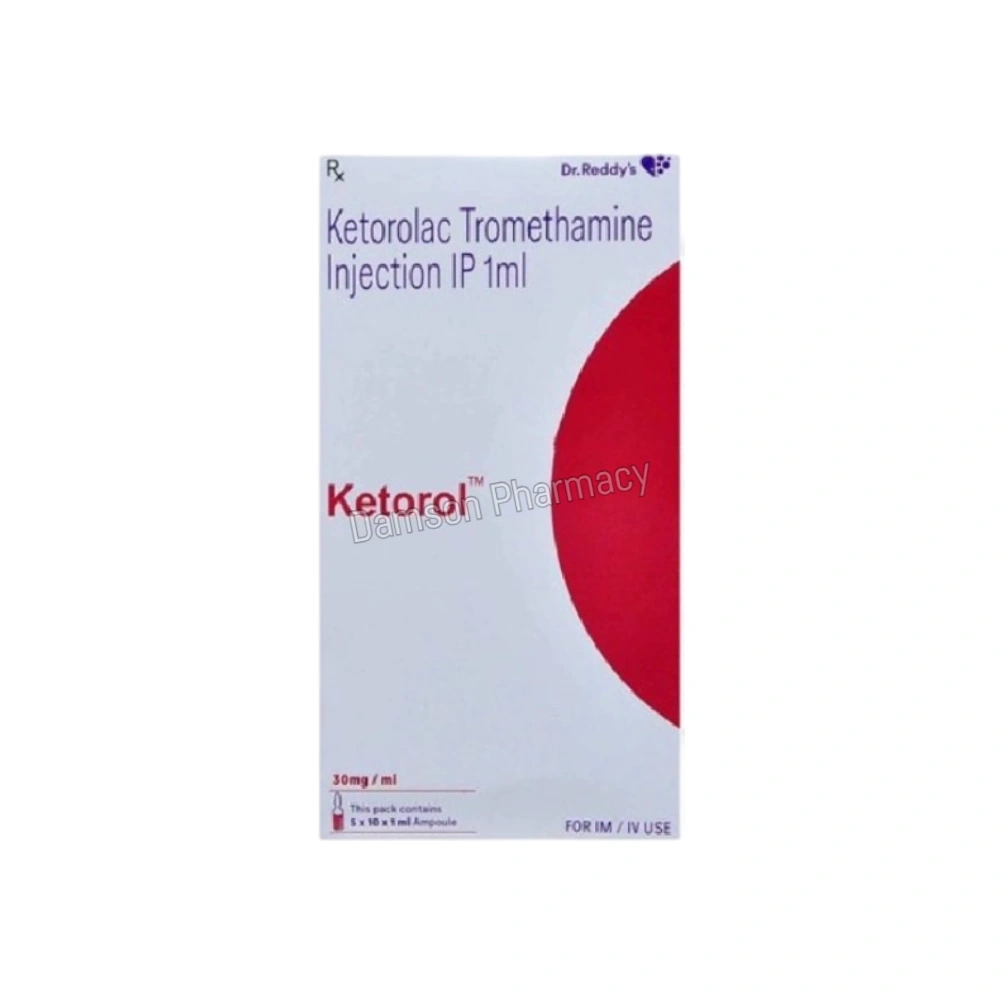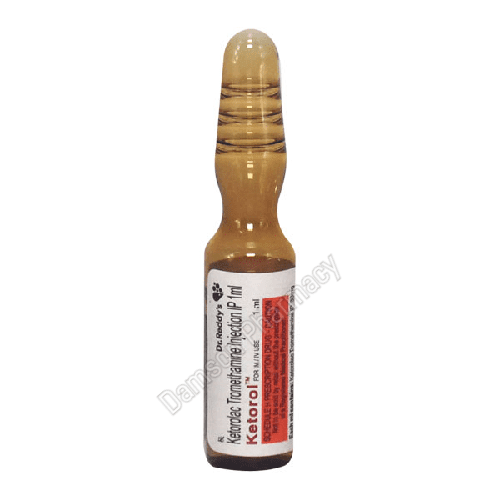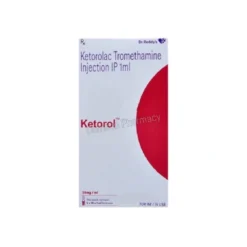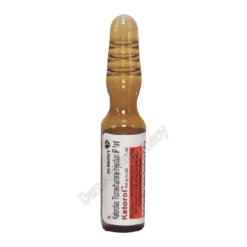Ketorolac Tromethamine Injection
$18.00 – $100.00Price range: $18.00 through $100.00
| Pack Size | Price | Price / Unit | Quantity | |
|---|---|---|---|---|
| 1 Injection | $18.00 | $18.00/ unit | ||
| 5 Injections | $75.00 | $15.00/ unit | ||
| 10 Injections | $100.00 | $10.00/ unit |
Want to order in bulk / B2B price ? | Send Inquiry |


| SKU | 11405 |
| Manufacturer | Dr Reddy'S Laboratories Ltd |
| Categories | Pain Relievers |
| Delivery Time | 10 - 14 Working Days |
| Strength | 1ml |
Introduction to Ketorolac Tromethamine Injection
Ketorolac Tromethamine Injection is a powerful prescription medication used to manage moderate to severe pain. It is often administered after surgeries or medical procedures to provide short-term pain relief when oral medications are not suitable or strong enough.
This injection is part of a group of medications known as nonsteroidal anti-inflammatory drugs (NSAIDs). It is valued for its rapid pain-relieving properties and is commonly used in hospital settings under medical supervision to ensure safe administration and dosage.
Ketorolac Tromethamine Injection is typically given via intramuscular (IM) or intravenous (IV) route by a healthcare professional. Its use is limited to a short duration—usually no more than 5 days—due to potential risks associated with long-term treatment.
Uses of Ketorolac Tromethamine
- Postoperative Pain Relief
- Musculoskeletal Pain
- Renal Colic
- Dental Pain
- Short-Term Pain Management
How Does Ketorolac Tromethamine Injection Works?
Ketorolac Tromethamine Injection works by blocking the production of certain natural substances in the body called prostaglandins. These substances are responsible for causing pain, inflammation, and fever. By reducing their levels, the medication helps decrease pain intensity and swelling at the affected site.
As a nonsteroidal anti-inflammatory drug (NSAID), it targets the source of pain at the chemical level without affecting consciousness or directly altering nerve perception. Its fast-acting nature makes it particularly effective for acute pain management in surgical or injury-related scenarios.
Side Effects of Ketorolac Injection
Common Side Effects
- Gastrointestinal Issues
- Dizziness
- Headache
- Rash
- Fatigue
- Swelling
Serious Side Effects
- Kidney Problems
- Severe Allergic Reactions
- Cardiovascular Issues
- Liver Damage
- Severe Skin Reactions
- High Blood Pressure
Dosage of Ketorolac Tromethamine Injection
The dosage of Ketorolac Tromethamine Injection is determined based on the patient’s age, weight, kidney function, and severity of pain. For adults, the usual initial dose is 30 mg intravenously (IV) or 60 mg intramuscularly (IM), followed by 15–30 mg every 6 hours as needed, not exceeding 120 mg per day.
In elderly patients or those with reduced kidney function, lower doses such as 15 mg IV or IM may be recommended to reduce the risk of complications. The use of Ketorolac injection is typically limited to no more than 5 days to avoid serious side effects like gastrointestinal bleeding or kidney damage.
How To Manage Side Effects?
- Stay Hydrated
- Take With Caution If You Have Stomach Issues
- Limit Duration of Use
- Monitor for Allergic Reactions
- Avoid Smoking
- Inform Your Doctor About Other Medications
- Regular Checkups
Warnings & Precautions
Before using Ketorolac tromethamine injection, it’s important to be aware of certain warnings and precautions. This information is provided to ensure the safe and effective use of the medication. Here are some important warnings and precautions for Ketorolac tromethamine injection:
1. Short-Term Use Only:
- Ketorolac Tromethamine should not be used for more than 5 consecutive days due to increased risks of serious complications.
2. Avoid in Pregnancy:
- Especially during the third trimester, as it may affect fetal circulation and delay labor.
3. Not for Use in Children:
- This medication is generally not recommended for pediatric patients unless specifically prescribed by a doctor.
4. Caution in Elderly Patients:
- Older adults may be more sensitive to its effects, especially kidney or cardiovascular risks.
5. Avoid Before or After Major Surgery:
- Except when used for specific surgical pain management, as it may interfere with blood clotting and healing.
6. Use With Caution in Asthma Patients:
- NSAIDs can sometimes trigger bronchospasm in those with a history of asthma or nasal polyps.
7. Monitor Kidney and Liver Function:
- Patients with existing kidney or liver impairment should be closely monitored when receiving this injection.
Storage
- Store Ketorolac Tromethamine Injection at 20°C to 25°C (68°F to 77°F).
- Avoid freezing the vials or ampoules, as this may affect the stability and effectiveness of the medication.
- Keep the injection in its original packaging to shield it from direct light exposure.
- Once opened, use immediately and discard any unused portion; do not save for later use.
- Store in a safe place away from children and pets to prevent accidental administration.
Frequently Asked Questions
1. Can I Take Alcohol While Using Ketorolac Tromethamine Injection?
Ans. It is best to avoid alcohol while receiving Ketorolac Tromethamine Injection, as it increases the risk of stomach bleeding, ulcers, and liver strain. Always consult your doctor regarding lifestyle adjustments during treatment.
2. What Should I Do If I Miss A Dose Of Ketorolac Tromethamine Injection?
Ans. Ketorolac Tromethamine Injection is usually given in a clinical setting at scheduled times. If a dose is missed, your healthcare provider will decide when or whether it should be administered. Do not attempt to take it on your own.
3. What Should I Tell My Doctor Before Receiving Ketorolac Tromethamine Injection?
Ans. Before receiving Ketorolac Tromethamine Injection, inform your doctor about any history of ulcers, kidney or liver problems, heart conditions, asthma, or if you are taking any other medications, including supplements or blood thinners.
4. Is Ketorolac Tromethamine Injection Stronger Than Regular Pain Relievers?
Ans. Yes, Ketorolac Tromethamine Injection is considered stronger than most over-the-counter pain relievers. It is typically used for moderate to severe pain, especially after surgery, and should be used under medical supervision.
| Pack Size | 1 Injection, 10 Injections, 5 Injections |
|---|---|
| Price/Unit | $10.00/unit, $15/unit, $18/unit |
Be the first to review “Ketorolac Tromethamine Injection” Cancel reply
Related Products
No related Products Found











Reviews
There are no reviews yet.